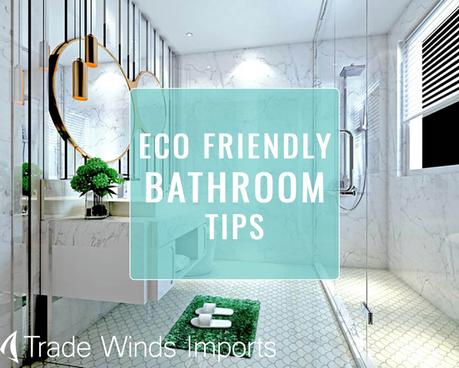
Is your bathroom behind the times?
An outdated bathroom can be one of the most displeasing rooms in the house to look at, and can be quite a big deal to sort out – they’re not just like another room that you can simply cover with a fresh coat of paint. Updating a bathroom’s aesthetic requires some skills and expertise, and may include the services of a plumber, tiler, and electrician.
However, when you have a bathroom that is truly outdated, it not only looks bad; it can also use up much more energy than a modern, state-of-the-art bathroom would. What’s worse, it uses up much more water than a modern bathroom, which is a major issue in many places in the world. And what’s even worse, an outdated bathroom may have abysmal air quality that could move out into other rooms in your home. In short, an eco-friendly bathroom isn’t just a nice aesthetic consideration. It has an impact on your bottom line, and even your health. So I ask you: can you afford an outdated bathroom?
Although bathroom renovations might be low on your job “to-do” list, it can be a good idea to update things sooner rather than later, before your energy bill becomes a dreaded thing in your inbox, or you start wondering why your hallways smell like mildew. Here are just a few ways to overhaul your bathroom and make it more Eco friendly, for your wallet and your life!
Contents
- I. Eco Friendly Fixtures
- 1. Dual Flush Toilets
- 2. Low-flow Showerheads
- 3. Motion Sensor Faucets
- 4. Reclaimed Wood Cabinets
- II. Environmentally-Aware Appliances
- 5. Energy Efficient Water Heaters
- 6. Low-Wattage Exhaust Fans
- 7. Skylight
- III. Green Decor
- 8. VOC-Free Paint
- 9. Sustainable Floor and Wall Coverings
- 10. LED Lights
- IV. Your Hygiene Habits
- 11. Choose Showers Over Baths
- 12. Take 5 Minute Showers
- 13. Don’t Shower As Much
- 14. Re-use Greywater on Plants or Laundry
- 15. Turn Off the Tap
- 16. Try Reusable Soap and Shampoo Containers
- 17. Don’t Wash Your Towels So Much
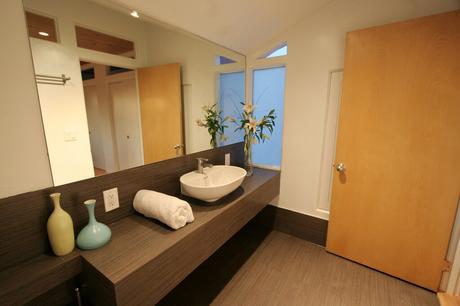
Eco Friendly Fixtures
Let’s start with some basics. The fastest way to a more sustainable bathroom lies in your fixtures. Swapping out your bathroom “tools” for green (or at least green-er) alternatives will have an immediate impact on your resource use. These fixes may require a fair bit of up front costs though, so you may have to be choosy how you tackle these replacements, sprinkling them in over the course of a year or two.
1. Low-flow or dual-flush toilets:
Toilets use quite a lot of water; in fact, they use around 25% of the water that gets consumed in your home. So if you have an old toilet, it can be wasting more water than more modern and efficient models. A low-flow model, or a dual-flush toilet, can be a good place to start if you want to get a more ‘green’ bathroom -they flush just as well as the old fashioned model, but use up only around one gallon of water per flush, compared to seven gallons per flush on average. That’s a lot of water savings!
2. Low-flow showerheads
Reducing the time your showers can take is one thing that significantly cuts down on water consumption in the home, but this tactic isn’t going to work for everyone. That is where a low-flow showerhead comes in. A typical American wastes between two and eight gallons of water per minute in the shower, with similar figures in the UK. When using a low-flow shower head, it will help to bring that number down to under two gallons per minute. With modern models, you still get the same amount of water pressure too! So for practically no detriment to the ‘feel’ of your shower you can reduce your water use and save money on utility bills – for a small upfront cost. Call that a win!
3. Motion Sensor faucets
Quite a lot of water can also get wasted at the sink. We can all use up more water than we really need when washing or brushing teeth. For a family, this amount of water wastage can really add up too, which is why motion-sensor faucets can come in to combat water wastage. The sensor will only come on when you have a hand there, and will switch off when not there. It can also be a more hygienic faucet, as you don’t have to touch it. You could also consider a low-flow faucet too, to save even more water.
4. Reclaimed wood bathroom cabinets
There are a number of materials that bathroom cabinets can be made from, including MDF, pressed wood, and plywood. However, these materials typically contain chemicals like formaldehyde and glues that emit considerable off-gassing, which can be harmful to your health and the bathroom environment (though they do qualify as having an acceptable amount of formaldehyde, they still emit Volatile Organic Compounds). So for a more eco-friendly and health-conscious bathroom, something like a reclaimed wood vanity would be a better choice than cheap MDF or plywood. Look out for FSC certified wood when buying bathroom cabinets, and consider using materials like bamboo, glass, concrete, or tile instead.
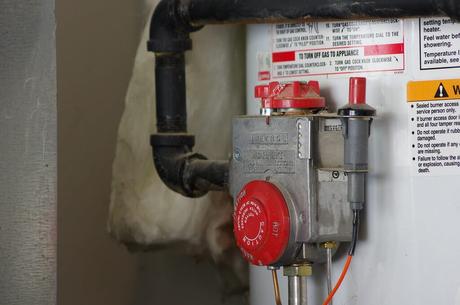
Environmentally-Aware Appliances
Those big household appliances taking up space in your garage may also be major culprits in your outdated home design. Better water heaters are a major boon if you want to limit your carbon footprint and water wasting, and better house ventilation may well begin in your bathroom, the site where mildew pops up most regularly (and subsequently, gets into your whole-house ventilation).
5. Energy Efficient Water Heater
If the climate where you live would be suitable for solar power, then this is something to consider switching to. Switching to a solar powered water heater for the whole house, not just the bathroom, can be a good way to create a more eco-friendly bathroom, as well as a more eco-friendly kitchen. If you have a traditional tank for your hot water, then it can be converted into a tankless (or “demand”) water heater, which will also use up less energy. A water heater can also become more efficient when it is insulated.
6. Low-wattage Exhaust fans
In many bathrooms, you can rely on the fans and vents to keep moisture under control. However, a good way to make the bathroom more energy-efficient is to replace an old fan or vent with one that is low-wattage and more energy-efficient. Even when it will only get used a couple of times a day, it will add up and make a difference to your utility bill bottom line. And it will still prevent mildew and moisture buildup just as well! You can learn more about bathroom fans and how much electricity they use on average over at SFGate.
7. Skylight
Bringing in a skylight into the home is something that can be energy-efficient, as it brings in plenty of natural light. It doesn’t compromise on privacy, but it does mean that you can light the room without having to have a lot of light bulbs and electricity.
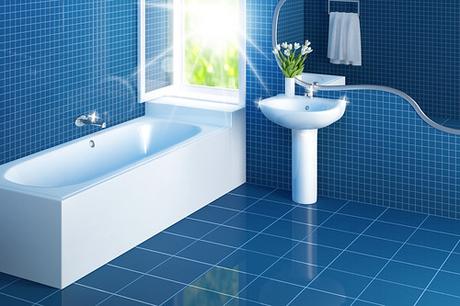
Green Decor
Who says an environmentally conscious bathroom can’t be pretty? And who says a pretty, but outdated, bathroom can’t be a source of some harm? Let’s green our bathroom decor, shall we?
8. VOC-free paint
VOC stands for volatile organic compounds, and they are chemicals that come from a whole host of materials and products. Many things in the home can contain them, and that can include the paint that you use in the home. If you want to reduce the amount of off-gassing that there is in your bathroom, then looking to use VOC-free paint will really help to create a safer, healthier, and much more eco-friendly space.
9. Sustainable floor and wall coverings
Using tiles in bathrooms is something that is common on the walls and the floors. But there are plenty of options that are eco-friendly too. Many tiles have recycled compounds in them, but you could also consider some wall and floor coverings out of other sustainable materials, such as cork, bamboo, or eco-friendly concrete. If you like the look and idea of wallpaper, then choose a PVC-free and VOC-free option.
10. LED lights
One of the best things that you can do for an eco-friendly bathroom is to switch to LED lights. The bulbs have come on leaps and bounds in recent years, meaning that you can get just the wattage and ambiance that you like, but use up much less electricity. Trade Winds Imports offers a full range of bathroom lighting that is perfectly suited to LED bulbs, so you can save energy in style!
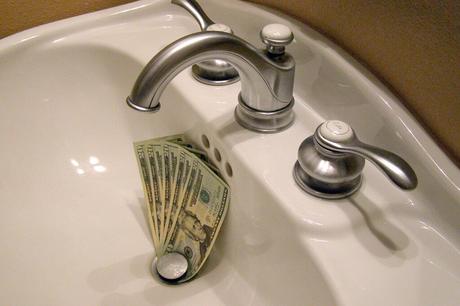
Your Hygiene Habits
As we’ve so often heard, responsible, environmentally friendly homes begin with our own choices. If you ignore the entire rest of this article and only change your habits, you’ll be well on your way to a more sustainable, healthier, and less costly bathroom!
11. Choose Showers Over Baths
There is no getting away from the fact that when you have a bath, you are going to use up much more water than when you have a shower. If you have a low-flow showerhead, then you will use up even less water having a shower. So to save yourself water and money, as well as time, go for a shower instead of a bath.
12. Take 5 minute showers
It is also a no-brainer that the shorter that your showers are, the less water that you will waste. It might mean setting yourself a timer, to try to be in and out within five minutes, but it will make a difference to how much water that you use. Have a quick shower, with a focus on the groin area and your armpits, and it can be enough. Team short showers with a low-flow showerhead, and you will be making a big difference to how much water that you use up.
13. Don’t shower as much!
Yes, you read that correctly! While there isn’t an ideal frequency of showers to have, expert research suggests that when you shower several times per week, rather than every day, then it is actually enough for the majority of people. If you are sweaty from sports or work, or have other reasons to shower more often, then go ahead. But for many people, every other day could be enough. You’ll save yourself time, money, and water, so can be a simple thing for a more eco-friendly bathroom.
14. Re-use Greywater on Plants or Laundry
How many of you already recycle ‘greywater’ that you have in the home? Greywater comes from the sink, showers, dishwashers, and washing machines. Instead of just letting it drain away, think about using it for other things. It could be used to flush a toilet or used to water plants in the garden. It can be used to pre-soak laundry, and much more. It is a good thing to get in the habit of, and can help you to be more sustainable.
15. Turn Off the Tap
We can waste so much water at the sink when we are washing our face or brushing our teeth. We leave the water running, as we will need to use it again, but it wastes so much! Instead, simply switch off the tap until you need to use it again. It is quick and simple to do; we just need to get into the habit of doing it, in order to make a difference.
16. Try Reusable Soap and Shampoo Containers, and Buy in Bulk
You can set up so many things in your bathroom to be eco-friendly, but if you fill it up with a lot of single-use plastic, then it won’t be a good thing. Instead, look for soap and hair product containers that can be used again and again, and source more natural options to refill them with. Buying soaps in bulk will also help you to save money and reduce waste.
17. Don’t Wash Your Towels So Much
As with anything that we wash, the quality of your bathroom towels deteriorates with every soak-and-spin cycle. Not only that, but using our washing machine too often leads to wasted water, as well as chemicals going into the water system that can be harmful to aquatic life. Not to mention, laundry machines use up a lot of energy! Towels don’t need to be washed after only one use, so bear that in mind. The Cleaning Institute recommends we wash our bath towels after 3 to 5 normal uses to prevent mold and mildew buildup.
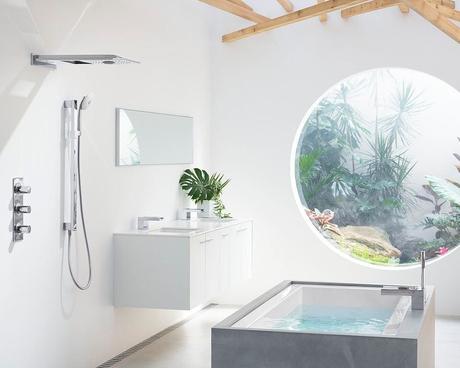
So there you have it. Just 17 of the hundreds of ways we can decrease our environmental footprint in the bathroom every day. I hope this has been informative and helpful, and I hope it helps you start taking just a few modest actions to help limit your own impact on our shared ecosystem, if you’re not already. Your planet, your body, and your wallet will thank you!
For any help with creating a more eco-friendly bathroom, or other bathroom design and ideas and tips, why not get in touch with us today? It would be great to hear from you.
Further Reading
- More on Saving Water with an Eco Friendly Toilet
- Bold Color Choices for Bathrooms
- Add Literal Green to Your Bathroom with These Bathroom-Friendly Plants
- 8 Bathroom Updates you Can Complete in One Weekend
- The EPA’s Tips for Conserving Water at Home
